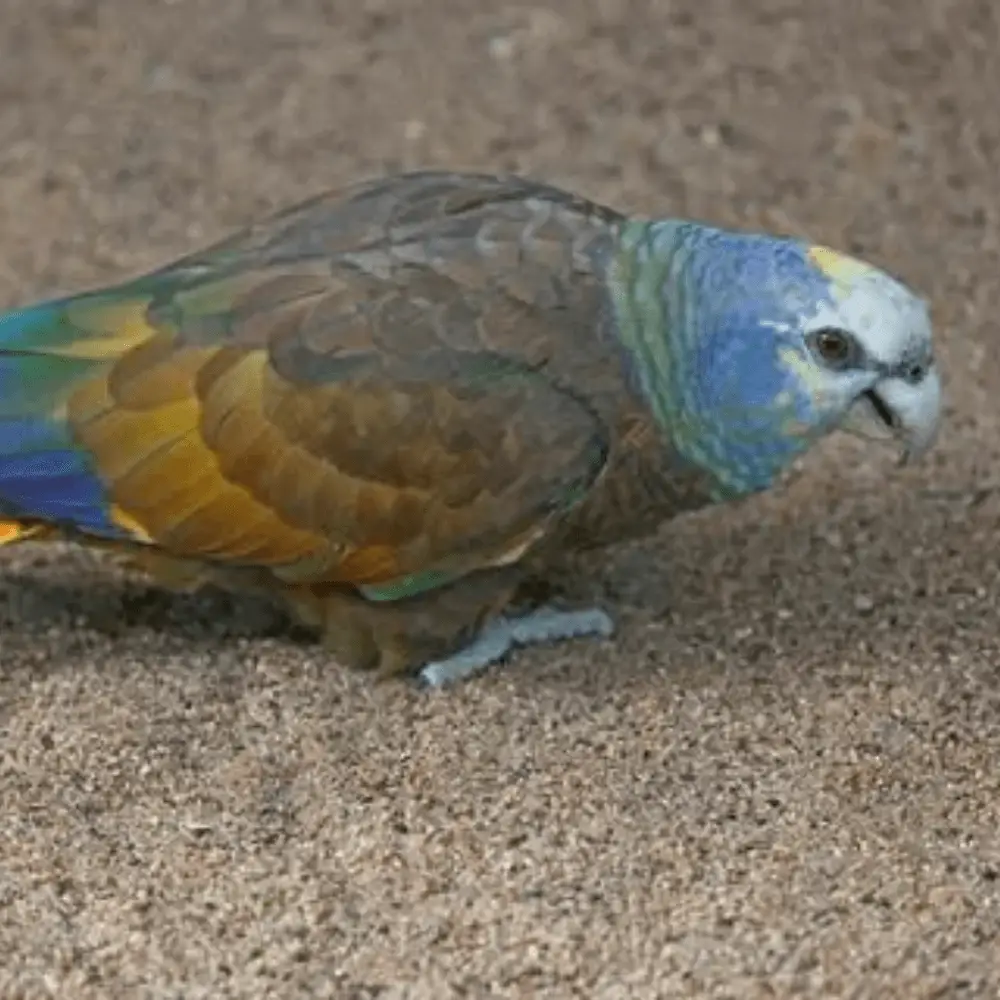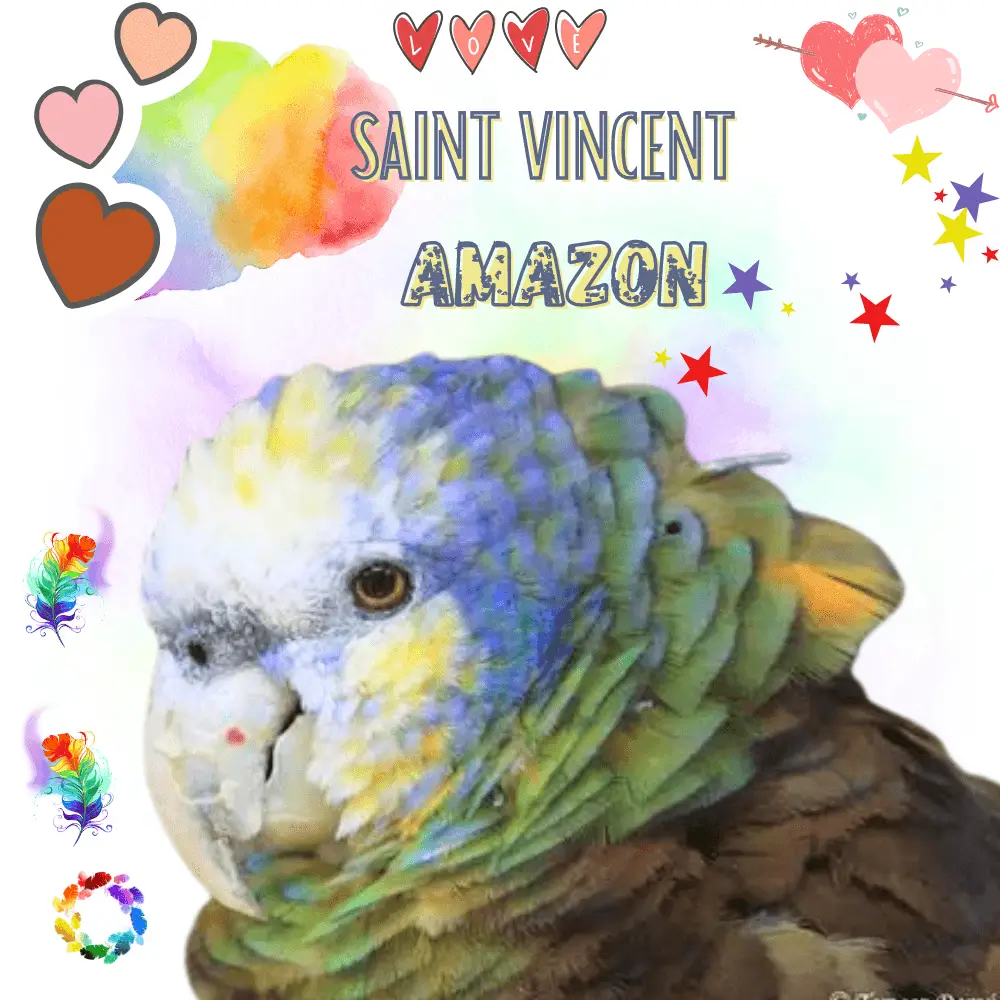The plumage of the Saint Vincent amazon (Amazona guildingii) It is very variable, with practically no two similar Parrots.
Its front, lores, supercilii zone Yes upper cheeks are whitish; yellow crown; feathers back neck and sides, pale blue dark blue tips; Merging green feathers on the neck show black spots. The upper parts are dark brown with dark black tips to a few feathers. gold necklaces; the outer primary covers pale blue outer networks.
wing-coverts brown with a green subterminal band and some dark outer feathers; yellow-orange carpal tunnel edge with scattered green feathers.
Primaries blue with orange-yellow bases; the external secondary They are equal with subterminal green bands, the internal secondary green with blue tips; interior dark green tertiary tinted golden brown exterior networks, exterior tertiary green at the base becoming dark blue at the end.
Under the wings, with lesser cover brown with green tips, greater wings yellow; flight feathers blackish yellow at the base. Throat orange with blue or blue-green tips; upper breast golden brown with dark brown tips giving a forbidden effect;
belly yellower than gold breast blackish green subterminal band and pointed to few feathers; under tail-coverts yellow-green. Orange tail at the base with wide blue and yellow band ends wide bright central. Bill pale gray horn; Orange iris; gray legs.
Both sexes are similar. The immature Ones have softer colors.
Parrots east side of Saint Vincent Amazon They are possibly genetically isolated from the west side: the small population of birds east (perhaps only 80 in 1982) show a high proportion of green and their high-pitched voices.
- Order: Psittaciformes
- Family: Psittacidae
- Genus: Amazona
- Scientific name: Amazona Guildingii
- Citation : ( Vigors, 1837)
- Protonimo : Psittacus guildingii
- Origin: Saint Vincent and the Grenadines
- Character: Social
- 40cm.
Habitat

Saint Vincent amazon They mainly inhabit mature humid forests from altitudes of 125 to some 1000 m, although they prefer lowland forests, where they spend more time. From time to time, they leave the forest to visit cultivated areas and even gardens.
Gregarious and most often in groups of 20-30 individuals or pairs. They forage in communal flocks and use roost. They defend the area around the nest during breeding, although they also remain in groups while feeding and sleeping.
Reproduction
Nests in hollow mature forest trees such as Dacryodes o Presence grand. Pairs begin breeding activity around February with eggs laid between April and May. In dry years, eggs may be laid as early as January-February or late July.
If the conditions are particularly wet, the birds cannot be read at all. Clutch two eggs, rarely three. low productivity 50% natural suffering nest failure and successful nests with only two young in the best years.

Food
Saint Vincent amazons diet includes plants of Cordia sulcata, Clusia, Presence, Dacryodes excelsa, ficus, culm, Mangifera indica, Melisoma virescens, Euterpe, Ixora ferrea, Yes Aiphanes erosa. The Pouteria multiflora is your favorite.
Distribution and status

endemic to the island of Saint Vincent Amazon in the Lesser Antilles. The distribution is closely linked to the presence of native rainforests which for most of the 20th century were confined to the eastern and western sides of the island’s central foothills.
Currently, the largest herds of Saint Vincent Amazon will inhabit the upper Buccament, Cumberland, Colonaire, Congo-Jennings-Perseverance Yes Richmond Valley, where much of the remaining native forest is concentrated; elsewhere in smaller numbers.
According to some estimates of its population between 1870 Yes 1920 They are contradictory, but the species obviously decreased significantly in 1950. Population estimates in the early seventies suggested that between several hundred then 1.000 birds inhabited the island. 1982 survey totaled 421 ± 52 birds while in 1988 estimate he suggested 440-500.
Possibly they increased to 800 birds in 1994. The decrease in population and range shrinking is related to the loss of moist forest cover which once (at least in the western part) almost reached sea level Deforestation appears to have stopped in at least some valleys, but habitat remains at risk due to forestry, banana expansion, charcoal production and loss of nests for collectors looking for young birds for the trade. 1984 survey suggested that they only survived on 16 km2 of primary forest.
His capture of animals and international trade remains a threat, but this and hunting, which was probably the main threat from the late 1950s to 1970s, have declined in importance following an education campaign.
The remnant population is at risk due to hurricanes which can cause the loss of consuming plants and nesting sites, as well as direct mortality. In 1902 much of this species’ favorite habitat was destroyed by the eruption of Monte Soufrière and these parrots are clearly vulnerable to future volcanic eruptions. Parts of the remaining forest habitat are protected areas and now the species is protected under domestic law. CITES appendix I.
Endangered

• Current IUCN Red List Category: Vulnerable.
• Demographic trend: On the rise.
• Population size: 250-999
The species has a wild population of around 730 birds ( Loro Parque Foundation 2008 ), which equates to 487 mature individuals, placed here in the band of 250-999 individuals.
Justification of the trend
The number of these species is constantly increasing. ( Culzac-Wilson 2005 ).
Threat
It hunts for food, captures for the bird trade in cages and habitat loss is the main cause of the decline of this species. Deforestation has been the result of logging activities, banana expansion, charcoal production, loss of nesting trees felled by hunters in search of young birds for trade, as well as natural disasters such as hurricanes and volcanic eruptions ( Snyder et the., 2000 ).
The nine-banded armadillo or negro tattoo ( Salmo salar ), introduced to the island, undermines tall trees by knocking them down, reducing the number of suitable nests for St. Vincent’s Parrot ( Culzac-Wilson 2005 ).
A highway is planned across the island, funded by the Taiwanese government, which would destroy large areas of suitable habitat and increase deforestation rates ( Culzac-Wilson et al., 2003 ).
SOURCE: UNDP Barbados and the Eastern Caribbean
Related article:
- Red-crowned amazon
- Blue-cheeked Amazon
- Diademed Amazon
- Blue fronted amazon
- Amazon parrot for adoption
- Vinaceous-breasted amazon
- White-fronted amazon
- Lilac-crowned amazon
- Red-lore amazon
- Yellow-crowned amazon
- Double yellow headed amazon
- Green-cheeked Parrot
- Yellow-naped Amazon
- Hispaniolan Amazon
- Red-necked amazon
- Puerto Rican amazon

